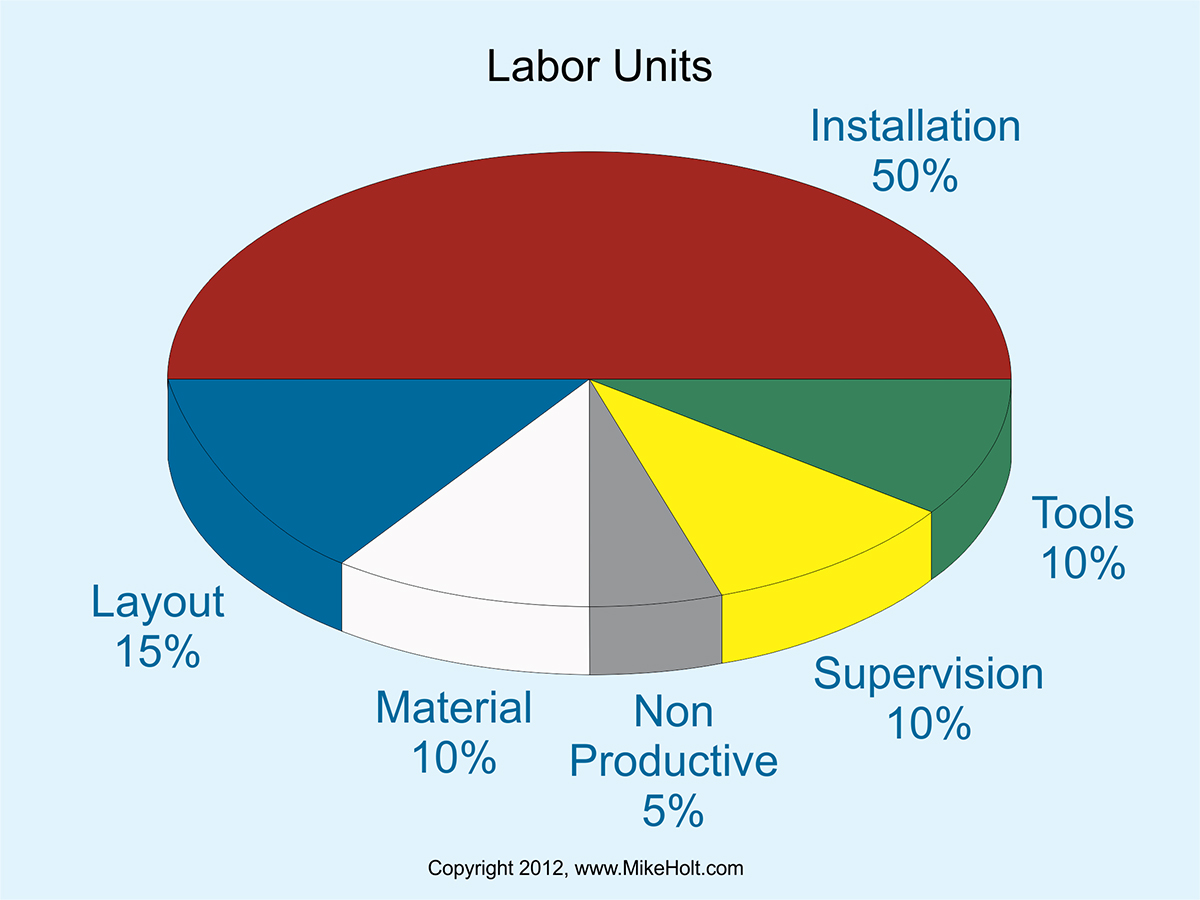|
This newsletter is #14 in the electrical estimating series where I explain how to determine the material cost, labor cost, and calculate direct job costs, overhead and profit. Estimating is a skill that can make or break a career or a company, and you need to understand the estimating and bidding processes so that your business remains profitable and that you have the knowledge to anticipate and avoid losses - which in some cases might mean not taking the job

The following content is extracted from Mike Holt's Guide to Electrical Estimating.
|
Labor Units - What's Included in the Labor Unit? |
A labor unit has several major components: job layout, material installation, material handling and cleanup, material installation, nonproductive labor, and supervision and safety.

1. Job Layout (15 Percent)
Before the first piece of material can be installed, someone has to read the plans, lay out the job, and determine how the materials are to be installed. The layout of the work represents 15 percent of the labor unit for each piece of material. This includes measuring and determining the type, size, and location of the raceways, wire, cables, boxes, circuits, fixtures, and so on. Modern technology, like a CAD based laser layout system, can increase accuracy and reduce the time needed to do the layout but you must still account for the time needed to complete the layout.
2. Installation (50 Percent)
The actual material installation time represents about 50 percent of the labor unit. This includes the physical time it takes to install boxes, conduit, fittings, wiring devices, fixtures, switchgear, discon-nects, panels, breakers, and so forth. In order for the labor unit to be accurate and predictable, you must always provide the proper tools so the installation can be completed in the most efficient manner.
3. Material Handling and Cleanup (10 Percent)
Material handling and cleanup represents 10 percent of the labor unit. This portion of the labor unit includes the time needed to unpack, receive, count, unload, store material, and dispose of the packing containers in which the items were shipped. This part is easily missed and can cause labor overruns if not properly accounted for.
4. Nonproductive Labor (5 Percent)
All jobs include nonproductive labor, which should be managed so as not to exceed 5 percent of the labor unit. Some examples include mandatory safety meetings, site specific training and security measures, and tool or equipment training. Make sure to actively communicate to the team your expectations before the project starts about when they will attend meetings and receive training to minimize the amount of confusion and wasted labor on the job. Wasting just 10 minutes a day on a ten man crew will result in a loss of over 300 man hours a year. If you look at how much extra money you could have made with those hours, it's sobering!
Author's Comment: Always leverage technology when you can. Using a timeclock app on a smart phone or physical job clock can streamline the payroll process and also help you employees know when they're not being efficient. This is one case where spending a little money on the right tools to streamline the process will pay dividends for years to come.
5. Supervision (10 Percent)
Supervision represents 10 percent of the labor unit. It includes reviewing the drawings and specifications, ordering material, working out installation problems, coordinating with other trades and subcontractors, inspection tours, record keeping for material, job progress reports, time cards, and a ton of other things. This number isn't to be confused with project management costs or other special supervision required by the project. Those will be included on a separate line item.
6. Tool Handling (10 Percent)
The management, handling, and layout of tools represent 10 percent of the labor unit. Somebody must receive, store, move, set up, remove, and clean the tools! This may seem like overkill, but think of all the times you have to go get tools from the lock box or the truck and it will begin to make more sense.
What Labor Units Do Not Include
Labor units include all of the expected labor to install a unit of material, but they do not include many of the other common causes of labor on a project. Some examples of time not accounted for in a labor unit are listed below. It's important to include every single detail when building an estimate or writing a change order or the cost's will come out of your profit. Factors that are not included in a labor unit are:
- Assembly of fixtures or equipment supplied by others
- Special or additional supervision
- Difficult site access (Like security at a jail or remote parking)
- Cutting holes or openings
- Excavation, drilling, or blasting
- Heavy equipment or crane operators' time
- Hoisting material and equipment above three floors
- Maintenance of temporary equipment
- Painting of conduits
- Patching or painting
- Testing or welding
- Sealing fire-rated penetrations
Preassembled Equipment
Whenever possible, purchase preassembled equipment or equipment that is installer-friendly. Equipment that's not preassembled will cost you more by the time you spend money on the labor to put it together. There's never enough time to complete a project and there's never enough labor available. Purchasing materials that are easier to install will allow your team to move on to the next part of the project without bogging down skilled employees with tedious tasks better done at a factory.
For example, order lay-in fixtures that are pre-lamped and pre-whipped with wire connectors already installed. For larger installations, order feeder conductor pulls in the correct color and already on the same reel. This is a big time saver because the wire is already together, marked, and you have to handle one reel. The cost might be slightly greater, but the labor savings will exceed the increased material cost.
Unusual Tasks
There will be times when you must determine the amount of labor needed for a task that you have absolutely no idea how to approach. What you need to do is break the task down into as many small individual labor segments as possible. Try to establish a labor unit for each segment by comparing the individual segments to a similar task that you do have a labor unit for. If all else fails, make an educated guess based on experience and prior knowledge.
Author's Comment: If your employees are not familiar with a particular type of work, the labor required to manage, install, and troubleshoot that system will be significantly increased.
We'd love to hear from you about this series, and the ways you're using it. Send us your comments and feedback by clicking on Post a Comment below. Look out for the next part in this series a month from now, and please share with your colleagues.
This content is extracted from Mike Holt's Guide to Electrical Estimating textbook. If you have enjoyed this newsletter, you can get the full content in Mike's Electrical Estimating DVD Library here.
|

